
Dwarf Puffers are incredibly rewarding fish, but they can be a little tricky. People usually pick them without knowing how to look after them and understanding how to care for them.
But no need to worry, when compared with other fishes, they are simple to Care of.
Dwarf Puffers are authentic freshwater puffers and require a varied diet, a decent amount of space, and proper water conditions.
Puffers have been known for their Intellect, fascination, and curiosity to find out what is going on outside the tank.
They tend to search each and every surface inside their tank carefully and remembers the spot where you usually feed them.
Table of Contents
Do Dwarf Puffer Puffs up:-
Yes, they do puff up, but it is rare; however, you might see puffing up in action if you are lucky enough.
Puffers do puff as a defensive mechanism or just for training/practice to prepare themselves from danger.
This usually happens with the younger puffers.
They usually inflate as a threat posture.
Poison in dwarf pufferfish
- The information available on the internet in the name of facts are selling you the Half-truths that are received through word of mouth or by replicating someone else’s work.
- To produce the toxin pufferfish require a specific type of bacteria and a particular type of algae found on the shells of certain molluscs. Unless either of those things is not present in the diet, no toxin is produced. This toxin is generally present in organs of the fish; only a little amount is present under the flesh.
- If the diet doesn’t have the bacteria and algae required, then there is no chance of generating toxins and,
- The toxin in the wild-caught puffers disappears eventually, with the periodical changes.
How Diet Affects Toxins
Captive-raised puffers do not develop the poison if they’re not confronted with the particular algae and bacteria within their daily diet.
Even though the toxin is found to be in wild-caught dwarf puffer, unless you eat the fish, it can’t harm you.
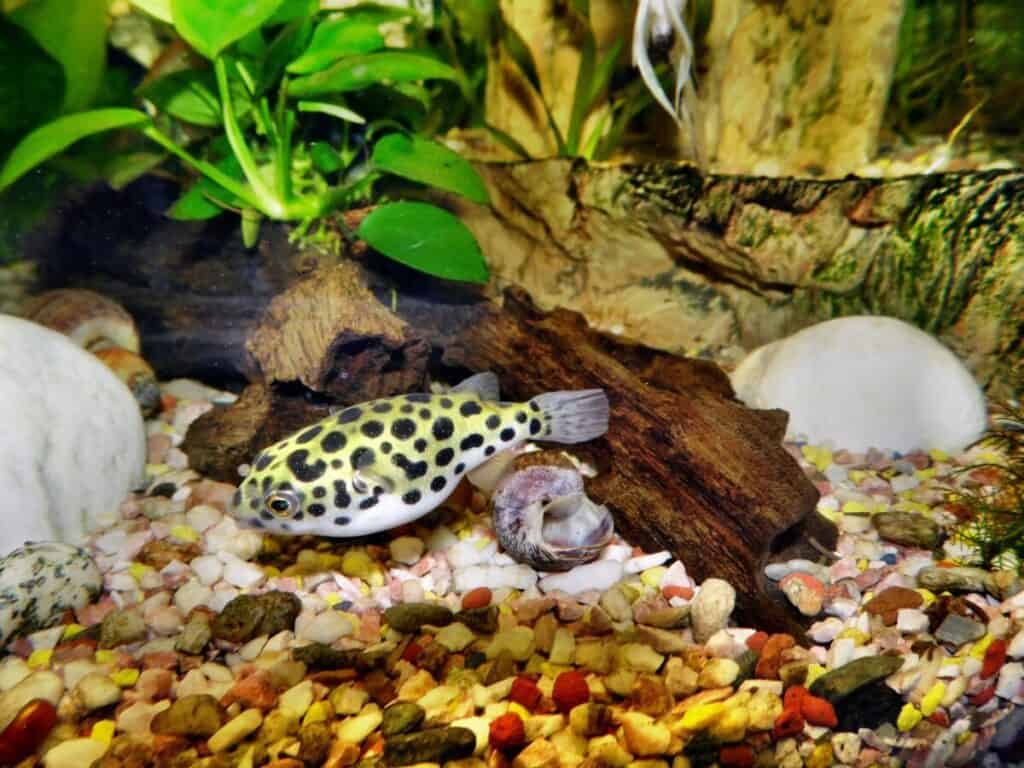
Behaviour
Unlike other species, pea puffers are fiercely territorial.
They are exceptionally social. Puffers usually are peaceful when they are young but will often become very aggressive when getting older.
They should never be kept alone, and they have to be with a 2:1 ratio of female and male; with females outnumbering males, at least a group of six should be kept with suitable male and female ratio.
By maintaining the proper ratio, they are much more confident and have a better feeding response, more social and less aggressive.
They are likely to become shy and nervous.
Captivity
Dwarf pufferfish are attractive, with the small cute size and colours, in recent times, they have become quite popular, and they are easy to maintain comparatively.
With the increase in popularity, as they are wild-caught, it is a significant threat to the species.
Dwarf puffers may help in controlling the snail population because they eat small live snails and are one of the rare aquarium fishes to eat them.

Appearance
Dwarf Pea Puffers were given their name due to their
exceptionally small size. They grow to the maximum length around 1.2 to 1.5inches, so they are one of the smallest fishes on the planet.
Their shape is round through the entire body and leans towards their spine end when looking at them, and you’ll discover their remarkably large eyes.
Male and female puffers differ in looks, which makes it easy for you to identify them. The significant difference you can find with is males have wrinkles around
their eyes.
Males have dark mixed green and golden shade colourings with the shiny yellow abdomen and thick dark stripes running upper body to the waist.
Females have the colouring of pale yellow and green shades mixed with the lighter plain yellow-white at the abdomen and has no stripes on them but have dark tiny black spots on the upper part of the body.
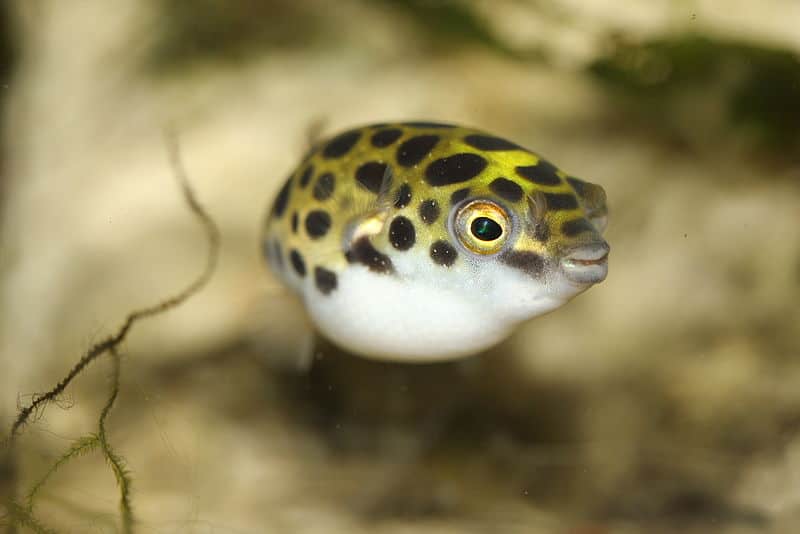
What do dwarf pea pufferfish eat?
Pea puffers hate flake foods; they should have a varied diet. It’s necessary to feed various foods when captivating dwarf pufferfish.
List of foods that they usually like to eat: –
Live foods:
- Brine shrimp
- Grindal worms
- Tubifex
- Bloodworms, Black worms, and white worms as treats
- Daphnia and Moina
- Snails like ramshorn snails, bladder snails etc. (They usually eat small snails)
Frozen/Dried foods:
- Pellets
- Dried bloodworms
- krill
- brine shrimp
- Shredded frozen mussels
- Mollusks/ crustacean etc
Before feeding any frozen or dried foods, make a habit of soaking them in water for around 20-30 minutes, so that they get re-hydrated. You can provide them by baster or pipette, or you can pour directly into the tank.
Always provide a mixed diet, try out these foods, and look at your puffer’s favourites.
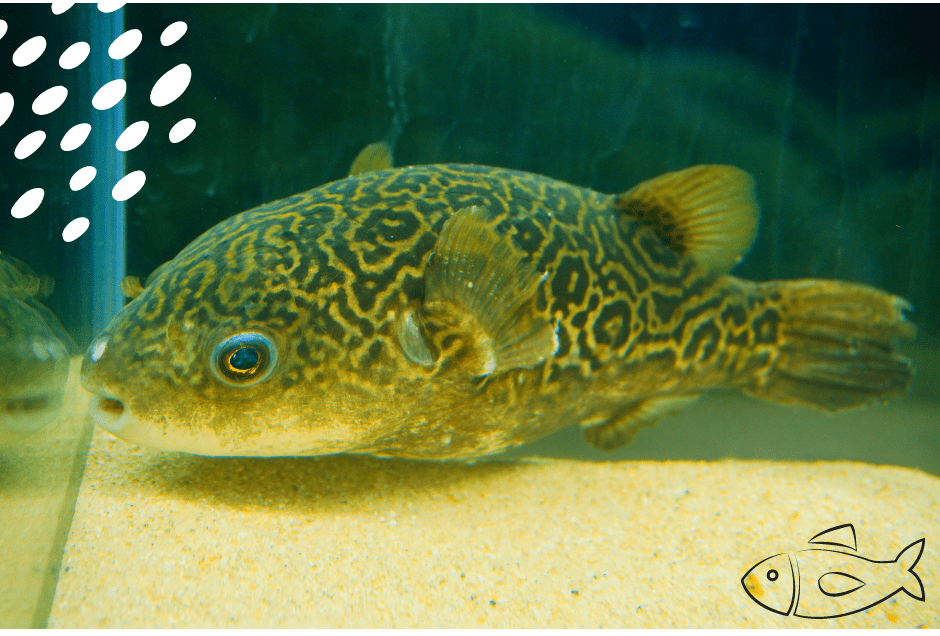
Can Pea Puffers Live with Other Fish?
This is one of the most common questions people ask about pea puffers, and it’s not an easy one to answer. Puffers are usually aggressive and territorial.
So, if you choose to keep them in community tanks, it might result in fin nipping. If you do keep them in community tanks, then small fast-swimming species are the best option.
Small, fast-swimming species-
- Ember Tetras,
- Neon Tetras,
- Glowlight Tetra,
- Filament Barb,
- Mosquito Rasbora,
- Zebra Danio,
- Leopard Danio,
- Harlequin Rasbora,
- Dwarf Otocinclus or Siamese Algae Eaters.
Even the fastest fish can become prey for puffers, so we never recommend or advise you to keep them with other species; if you do so, then make sure to have a separate tank set up in the case.
Never keep them with any long-finned or slow-moving fish, and Never keep dwarf puffers with small shrimp and snails like Bladder Snails or Malaysian Trumpet Snails.
Also, avoid keeping them with Catfish or with Guppies.
In the wild, these puffers are usually found with Filament Barbs, Long-finned Barbs, Paral Fish, Malabar Leaf Fish, etc.
Our recommendation is always to keep a separate tank for the puffers.
Tank setup
Within your aquarium, make sure you keep these fish in freshwater with a
- The temperature of 77-79°F and
- The pH of the water should be maintained between 6.5 to 8.
If you are using a filter, then point it towards the rear/back of the tank to maintain the water stream to a minimum.
The substrate needs to be either coarse sand or small particle gravel, allowing space for plant roots to disperse and spread around.
It would be best if you had a heavily planted tank, as it gives a more naturalistic feel for the fish, which keeps them interested, helps in providing breeding behaviour in the fish and includes plenty of dissolved oxygen to help your fish breathe.
There are a lot of plants to choose from, but Plants like Java Moss, Anubias Nana, and Stargrass would be a great choice.
Tank Size
If a group of 6 pea pufferfish is kept, then they should be housed in a 60-litre tank as a minimum, giving each fish 10 Litres of water each.
But for ideal housing, As per Ratio 2:1, if you choose three (2 female and 1 male) pea puffers then, a 10 gallon/38L will suffice.
An 18gallon/70L long can hold around 4-7 pea puffers easily depending upon the sizes and your experience level.
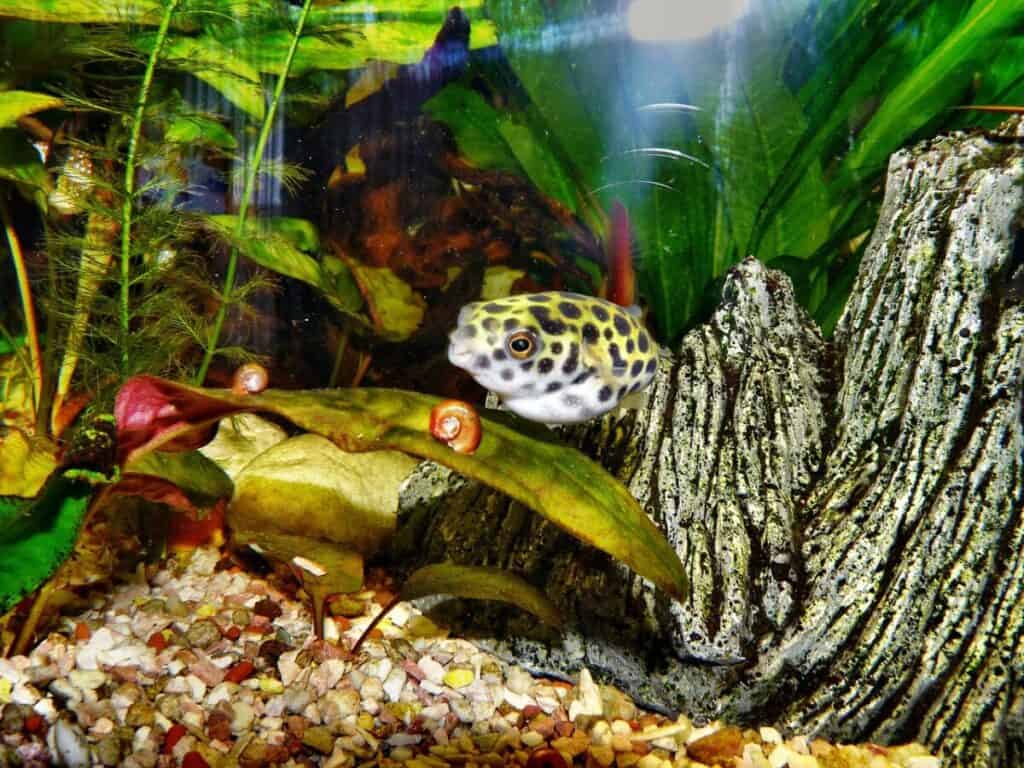
Housing and requirements for dwarf pufferfish
As mentioned above, puffers are pretty messy eaters. Because of this, they require a filter and routine water changes.
As usual, you need a de-chlorinator
You must and should have a Nitrate test kit.
Plants help remove nitrates with the frequent water changes, so they are essential, and pea puffers need enough plants around them because they need lots of hiding areas – not only to form territory but also to keep them interested.
As puffers are very sensitive to deteriorating water conditions, you should do a 40%-60% water change once a week. They could fall sick if a tank is left too long without a water change.
Puffers are curious and eager to explore; if they have nothing to explore, they quickly get bored. So they require plants, caves, and other hiding spaces to keep them interested in exploration.
They need multiple places to hide, and it is crucial when you have numerous puffers in your tank.
You can find out if your pea puffer is bored; it frequently scales the tank walls, looking for something to do.
Filter choice
As Puffers, not the fastest swimmers, you should also use a gentle filter with a slower flow rate. So, an underpowered filter is advised.
Wild waters are slow-moving, and they don’t have the body shape for turbulence. So, the filter needs to be significant, as the fish are messy.
If you do not manage your tank correctly, you can expect pollution as the puffer has enormous appetites and an affinity for spitting chunks of food out, uneaten scraps, etc.
Making a habit of removing uneaten scraps with a net or siphon hose after each meal would be a good practice.
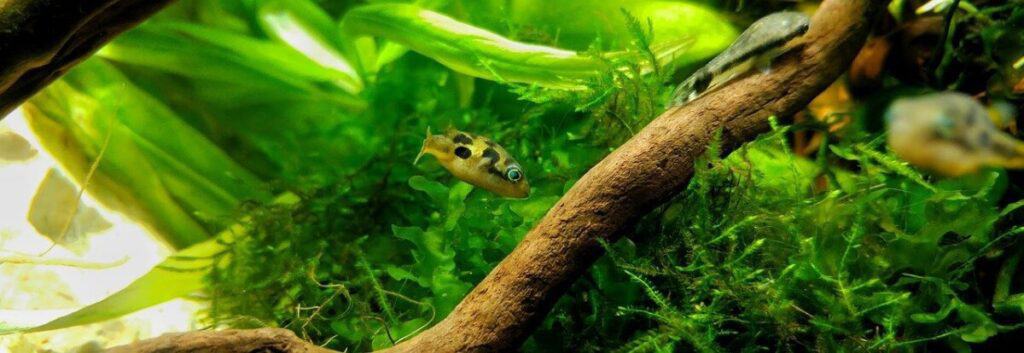
Do Pea Puffers Need a Heater?
Pea puffers do well in stable, tropical temperatures from 74 to 82°F. The ideal temperature would be in-between 77-79°F, so if your room temperature is below this range or tends to fluctuate a lot, you need an aquarium heater.
In terms of tank parameters mentioned above, the pH level of water should be maintained between 6.5 to 8.
A pH range between 6.8 to 7.5 is ideal, but it’s more important to keep the pH levels stable rather than aiming for the specific number.
Breeding/Reproduction of Dwarf pea puffer:
In Captivity, breeding of pufferfish is somewhat tricky. They
lay the eggs in plants or on hidden substances like caves but mostly in or near plants.
Most hobbyists observed that Java moss is the plant where puffer usually lay their eggs in.
So, maintain a heavily planted tank along with caves and things for them to keep interested. And, also for males to chase and roam around the female when they are ready to breed. The female will lead the male in one of the plants to spawn.
After spawning check the filter and water flow, accordingly switch your filter to sponge filter (maintain negligible water flow), so that the fry could be safe from getting sucked.
It is observed that Eggs usually hatch around 2-5 days @27 °C (81 °F) after they hatch, they are fed with infusoria (after 1-2 days hatching) after they are a week-old feed them with brine shrimp and later with the regular-sized food.
Pea puffers do not care about their eggs or fry(infants), so breeders usually keep the fry separately.
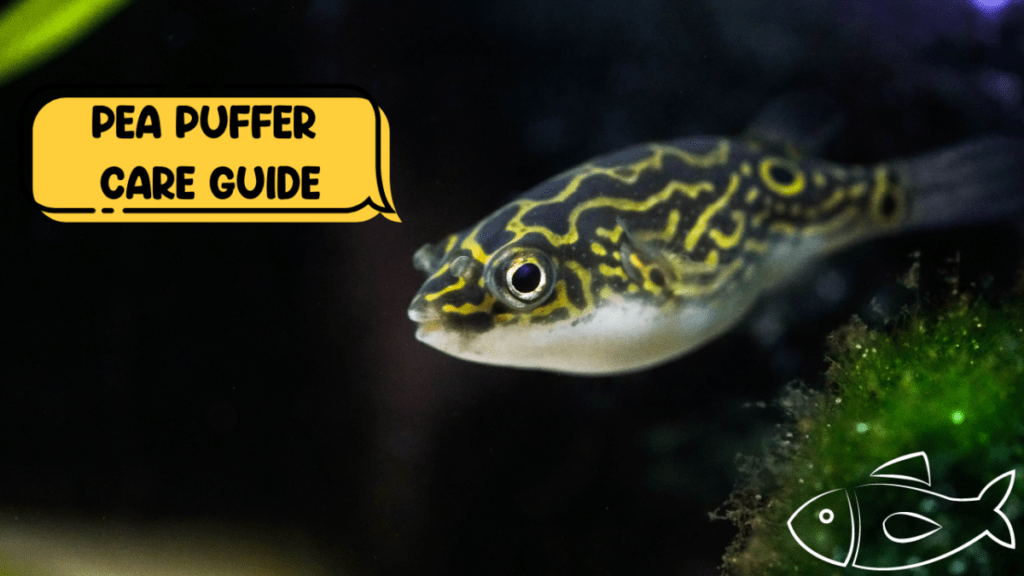
Steps to take Care of Dwarf Pea Puffer:
Dwarf Puffers are known for aggressive behaviour and are
territorial as I mentioned above, even towards the same species.
So, if you do not maintain the proper male: female ratio, then you may see nipping, and one of the puffers might get injured.
So, maintain 2:1 ratio, 2females:1male. Only then, they might get along, placing more males might lead to fighting and nipping, and one of them gets hurt, and flesh is taken out then you may see bacterial infections.
Maintain the proper temperature levels, keep changing water frequently, keep an eye on the filter and the water flow, keep checking nitrate level and maintain appropriate parameters of water mentioned above.
If the maintenance goes wrong, it may drop your fish’s immunity levels, may lead to infections (like commonly seen-white spot disease) and might lead to the death of fish.
It may be hard to find the infection if occurred, but you may notice the difference with your fish and If you have doubts or find any infections, reach out to the local store immediately.
Is the Pea Puffer Right for Your Aquarium? (Summary)
Dwarf puffers are an excellent start to begin fish keeping with, so even beginners or hobbyists and expert fishkeepers’ puffers are perfect for you.
Pufferfish are extremely rewarding fish; they are intelligent, curious and are aware of surrounding looking closely all over the room and explore every part in the aquarium.
As I mentioned above, if you maintain proper male: female ratio, mostly you won’t have a problem with hunting and fight amongst. Keep multiple females.
Don’t keep any other fish along with them. Just maintain everything right as I mentioned above, and you are good to go.
